The Flying Boats of Foynes
Published in Features, Issue 1 (Spring 2001), Northern Ireland 1920 - present, Volume 9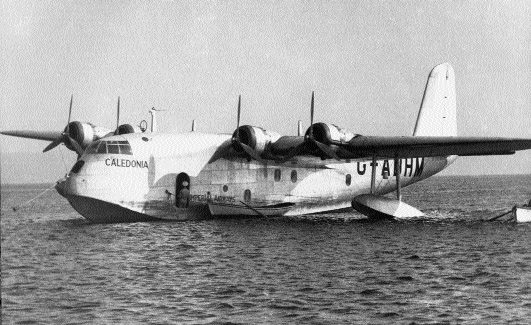
Imperial Airways Short S.23 G-ADHM Caledonia-one of the first flying boats into Foynes in 1937. (Foynes Flying Boat Museum)
The story begins in 1935, when by the Montreal Agreement, the governments of the USA, the UK, Canada and the Irish Free State ruled that all transatlantic aircraft would land at an Irish airport when travelling east or west. Foynes is today, as it was then, a small town on the south side of the Shannon estuary on the road from Limerick to Tralee. Its geographical position on the west coast of Ireland, its sheltered harbour with a long stretch of calm water and its railway connection to Limerick and beyond, which had existed since 1858, were all important factors which resulted in the announcement in the Irish Times, on 16 December 1935, that Foynes would be the European terminal for transatlantic services. At that time, crossing the 3,000 miles of the North Atlantic with a worthwhile load of passengers or freight and the large quantity of fuel required, represented a huge technical challenge. Moreover there were few, if any, airports with runways suitable for the large and heavy machines envisaged. Therefore flying boats were the preferred option. By 1936, wireless telegraphy stations were under construction at Rineanna (now Shannon Airport) and Foynes. Later that year, on 28 October, the first experimental radio messages were sent from Ballygirreen (near Rineanna) to Gander in Newfoundland.
First flight
On 25 February 1937 the first flying boat, the Short S.23 G-ADUV Cambria of Imperial Airways flown by Capt. G.J. Powell landed at Foynes from Southampton. The first of the S.23 class to fly was G-ADHL Canopus which took off from Short Brothers’ Rochester works on the River Medway, Kent, on 4 July 1936. It was an advanced design for its day, with four Bristol Pegasus radial engines mounted on a high wing above the spacious fuselage. It had a wingspan of 114 feet and measured eighty-eight feet in length. Its cruising speed was 165 mph, with a range of 760 miles. It could carry a maximum of twenty-four passengers, five crew and one and a half tons of mail. It was designed not for the Atlantic route but for Empire passenger and air mail services to Africa, India and Australia. It was a luxurious way to fly and an icon of the period. Passengers had a promenade lounge on which they could stroll while the normally rather cramped pilots’ cockpit was replaced by a flight deck. Imperial Airways ordered twenty-eight of the type straight off the drawing board, a quite unprecedented decision.
In 1937 two Short S.23 flying boats G-ADHM Caledonia and G-ADUV Cambria were stripped of all non-essential fittings and fitted with additional fuel tanks. Their range was thereby increased to 3,300 miles. On 5-6 July, Caledonia, commanded by Capt. A.S. Wilcockson, took off from Foynes for Botwood in Newfoundland. Coming in the opposite direction was Capt. Harold Gray in the Pan American Sikorsky S42B N16736 Clipper III, which was similarly specially equipped. Both flights were successful and flew on to New York and Southampton respectively. Capt. Wilcockson commented on his flight of 1,900 miles, at an average speed of 132 mph and in a time of fifteen hours and three minutes: ‘It was a great trip. It shows that a regular transatlantic mail and passenger service is quite feasible.’ With the advantage of the prevailing winds Clipper III made the eastbound crossing in twelve hours and thirty-one minutes. One of the major dangers was ice—not icebergs, but the formation of ice on the surface of the aeroplane gathered from ice-bearing clouds. The accumulation of ice added to the weight and drag of the aircraft, two factors not conducive to sustained flight. (The basic theory of flight involves four forces, two positive and two negative: if the lift generated by an aeroplane’s wing shape and the thrust provided by its engines are greater than the weight of the machine and the drag caused by its shape, then it will fly.)
Nine more return flights were made by Imperial Airways and Pan Am in that year. It had been proven that the journey could be undertaken on a regular basis, overcoming the hazards of ice, headwinds and cloud, but how could a commercial payload be achieved? Other nations were also taking an interest in Foynes. On 15 July 1938 a French flying boat, a Latecoere 521 F-NORD Lieutenant de Vaisseau Paris of Air France landed. Its purpose was an inspection visit of possible landplane airfields, including Rineanna and Collinstown (later Dublin airport).
The Short-Mayo composite
One solution to the problem of range was to use two machines—the Short-Mayo composite project, which comprised a modified S.23 ‘C’ class boat, the C.21 Maia G-ADHK and the S.20 seaplane Mercury G-ADHJ. Maia acted as the mother ship, using its fuel to lift Mercury into the air.
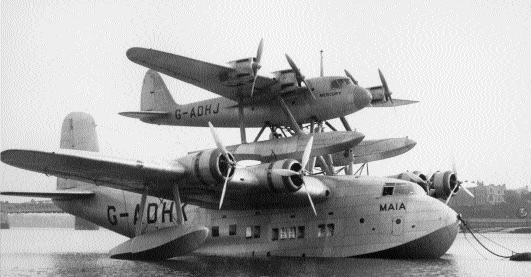
Maia’s wing chord was increased to give an extra 250 square feet of wing area to enhance lifting capacity. The engines were moved outboard and the fuselage broadened to accommodate Mercury atop its framework. After a series of successful test flights, a crossing of the Atlantic with a full payload was attempted. On 21 July 1938, the composite took off from Foynes, Maia flown by Capt. Wilcockson and Mercury by Capt. D.C.T. Bennett (later Air Vice Marshal Bennett, creator of the Pathfinder Force). Once out to sea, the locking device was released; Maia dropped away in a gentle dive, as the four Napier Rapier 340 hp engines pulled Mercury away on its twenty-hour twenty-minute non-stop flight to Montreal with 1,000 lbs of mail, newspapers and newsreels. The composite was used successfully as a mailplane on a variety of other routes until the war intervened.
Air-to-air re-fuelling
Composites were deemed too risky for passenger carrying, as was the other British experiment—air-to-air re-fuelling. The system was developed by Sir Alan Cobham and a weekly mail service was inaugurated on 5 August 1939, on the Southampton-Foynes-Botwood-Montreal-New York route, the Short S.30 G-AFCV Caribou, flown by Capt. J.C. Kelly Rogers, being re-fuelled by the Handley Page Harrow G-AFRL, in the experienced hands of Flight Refuelling Ltd’s Geoffrey Tyson. The tanker was based at Rineanna and two others, G-AFRG and G-AFRM, waited across the Atlantic at Hatties Camp (later named Gander). It took twelve minutes to transfer 800 gallons of fuel between the aircraft flying at 125 mph, with a snaking hose connecting the receiver and the tanker in formation above and ahead. Some sixteen successful flights were completed before being discontinued when hostilities commenced.
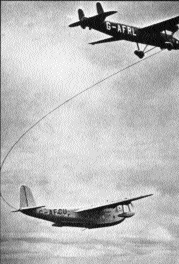
Air-to-Air re-fuelling. (Foynes Flying Boat Museum)
Kelly Rogers commented that whilst the operation was technically feasible, fuel leaks on five occasions into the hull of the flying boat had been a safety hazard which rather limited passenger appeal. His prescient recommendation was that the way ahead was with pressurised landplanes operating at 16-20,000 feet, above ice-bearing cloud.
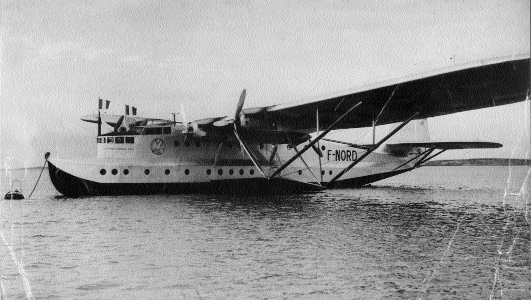
On 15 July 1938 an Air France flying boat, a Latecoere 521 F-NORD, Lientenant de Vaisseau Paris arrived at Foynes. (Foynes Flying Boat Museum)
Quite a stir had been made on the ground as well, as en-route to Foynes, Kelly Rogers flew over Dublin to allow the populace a better view of the aeroplane. When he landed at Foynes he was greeted not only by the Taoiseach, Éamon de Valera but also by hordes of sightseers, hundreds coming by special train from Limerick and others by car, jamming the narrow roads.
Yankee Clipper
Meanwhile, spurred on by Juan Trippe, the dynamic owner of Pan Am, the Boeing Airplane Company had come up with a true transatlantic, commercially viable flying boat—the stunningly beautiful B.314 Clipper. On 11 April 1939 the first Boeing B.314 Yankee Clipper NC18603 flown by Capt. Harold Gray landed at Foynes (front cover). Just as Glenn Miller or Artie Shaw seemed more modern than the British dance band leaders Henry Hall or Geraldo, so the streamlined Boeing seemed to epitomise the future rather than the more rounded shape of the Empire boats. This proving flight was followed on 28 June by the first mail flight, again flown by the Yankee Clipper and Capt. Gray.
Two weeks later, on 9 July 1939, Yankee Clipper landed at Foynes to complete the first commercial passenger flight on the direct route between the USA and Europe. The B.314 could carry thirty-five passengers in sleeper accommodation, the dining room could seat fourteen for a seven-course meal. Two stewards prepared all the food from scratch. Afterwards, diners could stroll on the observation deck and enjoy the view. There was even a private honeymoon suite at the rear of the aircraft. The problem of crew fatigue on non-stop long distance flights was also addressed, with sleeping quarters abaft the flight deck and cargo hold for a complete off-duty crew. Two small hatches on either side of the flight deck allowed access inside the wings to the engines while in the air. The aircraft was also fitted with rubber de-icing ‘boots’ on the leading edges of the wings and tail, which could be inflated to splinter and remove ice. It was powered by four Wright double Cyclone radial engines, each of 1,500 hp, weighed thirty-five tons, cruised at 188 mph and had a range of 3,685 miles.
World War II
On 1 November 1939, Imperial Airways ceased to exist with the creation of BOAC, the British Overseas Airways Corporation. The transatlantic link was resumed in 1940, when the darkly painted and camouflaged Short S.30s G-AFCX Clyde and G-AFCZ Clare made six return crossings of the Atlantic with passengers. The first trip, designated NA W9, was on 3 August, flown by Capt. J.C. Kelly Rogers. One of the passengers was Colonel ‘Wild Bill’ Donovan, special advisor to President Roosevelt. On Clare’s return passage one week later, four of the six passengers were the first American civilian pilots to be recruited for the ferrying of military aircraft to Britain. The following year the S.30s G-AFCT Champion, G-AFKZ Cathay and Clare maintained the Poole-Foynes shuttle, while the Atlantic crossing was given over to BOAC’s newly acquired Boeings.
During the war, three Boeing B.314s were operated by BOAC across the Atlantic, G-AGCA Berwick, G-AGCB Bangor and G-AGBZ Bristol. Twelve in all were built, sadly none survive. The inaugural flight was made by Capt. J.C. Kelly Rogers in Bristol on the Foynes-Lisbon-Bathurst-Lagos route on 22 May 1941. As the aircraft required very regular maintenance in Baltimore, transatlantic passenger flights via Botwood were slotted into this schedule. For the rest of the war, the three flying boats operated this Foynes-Lagos-Baltimore circuit. In winter when Botwood was iced up, the route was from Bathhurst to Baltimore via Belem in Brazil, Trinidad and Bermuda. The Shorts aircraft to rival the B.314 was the ‘G’ class S.26, which arrived too late for peacetime transatlantic work and instead served with the RAF as patrol aircraft and then in a passenger role from England to Africa and the Indian Ocean.
One particularly famous flight from Foynes in June 1942 concerned Admiral Sir Andrew Cunningham, the commander-in-chief of the Royal Navy Mediterranean fleet. His pilot was Charles Blair, the chief pilot of American Export Airlines, which between April 1942 and 1945 operated 405 crossings from Foynes to New York on behalf of the US Navy Air Transport Service. The aircraft was a Vought-Sikorsky VS44A NC41880 Excalibur 1 which could carry sixteen passengers at 175 mph and had a range of 4,545 miles. It was given the designation JR2S-1 by USN but flew in civilian markings. The normal routine was to make a re-fuelling stop in Newfoundland but as there were a thousand gallons of fuel left, Blair, ‘began to toy with the idea of going the whole way’, and kept on flying. He landed in New York twenty-five hours and forty minutes after leaving Foynes, having made the first non-stop commercial flight from Europe to the US city—with ninety-five gallons of fuel left in the reserve tank, enough for another 100 miles. ‘Remarkable voyage’, commented Admiral Cunningham.
Passing VIPs
Other VIPs to pass through Foynes included, Ernest Hemingway, Anthony Eden, John F. Kennedy, Lord Mountbatten, Yehudi Menuhin, Eleanor Roosevelt, Bob Hope, Gracie Fields, Douglas Fairbanks Snr and Humphrey Bogart.
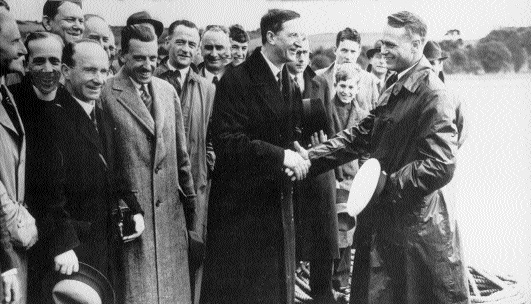
í‰amon de Valera, who had a keen interest in aviation, greeting Capt. Harold E. Gray, commander of the Pan American Yankee Clipper and Clipper III, 6 July 1937. (Foynes Flying Boat Museum)
Southern Ireland was, in theory, neutral during World War II but most passengers were top level Allied military and diplomatic personnel with the necessary high priority status required for transatlantic flights. Many were on active duty and travelling under false passports. At first the airlines were very circumspect about the identity of many of these passengers but as the war progressed more American military uniforms were seen. There is no doubt that, with the tacit approval of the Irish government, the flying boat base was a very important link in the Allied war effort.
Shorts flying boats were frequent visitors to Foynes during World War II. S.30s serving the West Africa route from Poole to Lagos flew to Foynes, first to avoid overflying occupied Axis territory, and also German fighters over the Bay of Biscay. S.25 Sunderlands connected with the transatlantic flights and took passengers to England. Aircraft of this type were the greatest users of Foynes. Sadly one of these had a fatal accident on 28 July 1943, when G-AGES from Lisbon with eighteen passengers, seven crew and 30,000 letters from POWs in Japanese prisons crashed in Kerry. Ten of those on board lost their lives.
Two unusual items of freight were transported in 1944. On 22 July NC18612 Cape Town Clipper brought three queen bees for St Patrick’s College, Maynooth, and on 21 August, the same aircraft arrived with a consignment of the new and scarce wonder drug, penicillin.
The end
As for commercial flying boat operations at Foynes, the return of peace in 1945 heralded the end. A few more notable achievements included on 26 June 1945, the arrival of the first fresh flowers (orchids) to be flown across the Atlantic and on 12 July that wartime rarity, a bunch of bananas for a sick child, in both cases on board the Cape Town Clipper. The record breaking day for Pam Am operations at Foynes was 18 August 1945. Two aircraft, NC18604 Atlantic Clipper and NC18605 Dixie Clipper arrived from New York and returned that night. In all 101 passengers were handled. On 29 October 1945 Pan Am’s final flight from Foynes to Lisbon was flown by Capt. Wallace Culbertson in NC18609 Pacific Clipper. One of the passengers was George Hice of Brooklyn who remarkably was also a passenger on the first Pan Am flight in 1939. Since 1939 the Boeing Clippers of Pan Am made 2,097 Atlantic crossings via Foynes. Regrettably not one of these magnificent aeroplanes was preserved, all were scrapped by 1952.
Sir Winston Churchill flew in Berwick, captained by J.C. Kelly Rogers and commented, ‘I travelled in an enormous Boeing flying boat, which made a most favourable impression on me. I took the controls for a bit, to feel this ponderous machine of thirty tons or more in the air.
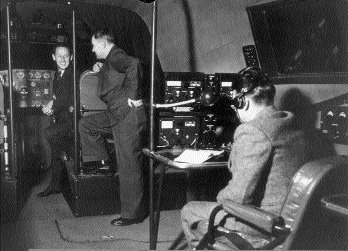
The spacious flight deck of a Boeing 314 Clipper.
I got more and more attached to the flying boat.’ He was equally impressed by the catering facilities, ‘where nothing was lacking in either food or drink’. Many years later, as a senior manager with Aer Lingus, Capt. Kelly Rogers loved to recall his wartime experiences with the great prime minister—to such an extent that it was rumoured that Sir Winston was writing a new book, entitled I Flew with Kelly Rogers.
By 1946 BOAC was also running down its services through Foynes. Bangor arrived from Bermuda on 16 January and departed for Poole the following day. Sistership Bristol completed the same route on 21 February. The final BOAC aircraft to visit Foynes was the Short Sunderland G-AGJO on 24 March 1946. Services were now much more infrequent. On 13 October 1947 the Boeing B.314 NC18612 Bermuda Sky Queen of American International Airways arrived in Foynes with sixty-one passengers, the greatest number ever flown across the Atlantic in a flying boat. Then on 17 October 1949 the Short Sunderland G-AGKY Hungerford of Aquila Airways departed Foynes after completing a short series of charters to Fatima.
Technological advances fuelled by the needs of war had resulted in the rapid development of landplanes capable of true intercontinental flight. As Kelly Rogers had predicted pressurised landplanes travelling at much higher speeds and at much higher altitudes (thus avoiding ice-bearing clouds) were the future. Moreover, the requirements for ever heavier and larger bombers, patrol aircraft and transports had resulted in the proliferation of long concrete runways which could readily serve civil needs. Shannon was ready to pick up the next part of Ireland’s aviation story.
A romantic and nostalgic swansong or two remained. Charles Blair, having become famous not only as the husband of Maureen O’Hara but also as the owner of Short Sandringham Southern Cross N158C and of the last Sunderland ML814, returned to Foynes in Southern Cross in 1976 and 1977. While owned by Edward Hulton, the ML814 Sunderland made the trip to Foynes in 1989, renamed Spirit of Foynes.
Foynes Flying Boat Museum
Three-quarters of an hour’s drive from Shannon along the N69 road via Limerick can be found a gem of a museum. Today the Foynes Flying Boat Museum is situated in the original four-storey terminal building with the glazed watch room added on the roof. It was built in the 1860s and in former days had been the Monteagle Arms Hotel. The museum features an excellent film presentation with much historic footage in its 1940s-style cinema, memorabilia of Charles Blair, very informative displays on the history of transatlantic flights, the original radio and weather room and a splendid model of the flying boat base. All it lacks is a flying boat. Perhaps Kermit Weeks, millionaire owner of Fantasy of Flight in Florida and the current owner of the last airworthy Sunderland ML814 will visit it one day.
Guy Warner is a member of the Ulster Aviation Society, the Aviation Society of Ireland and Air-Britain.
Further reading:
P. Smith, The Last Flying Boat (Southampton 1993).
A.S. Jackson, Imperial Airways (Lavenham 1995).
E. Jablonski, Seawings (London 1974).
C. Cruddas, In Cobham’s Company (Wimborne 1994).
















